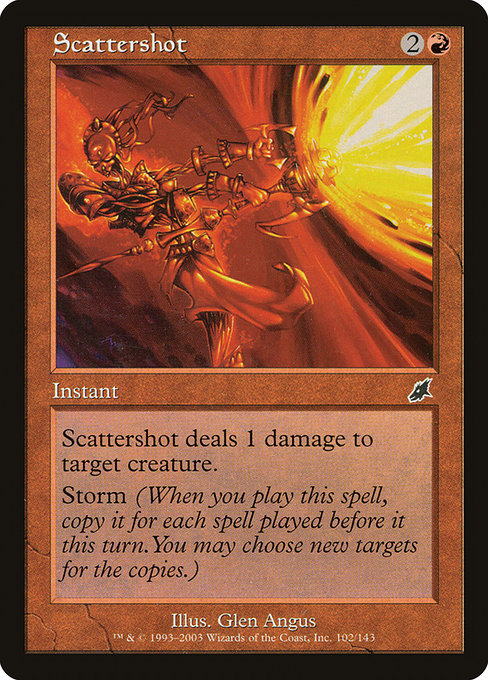
Image courtesy of Scryfall.com
Scattershot: A Glimpse into Red Storm Art Across Sets
There’s something distinctly kinetic about Scattershot’s artwork. Painted by Glen Angus for the Scourge block, this red instant is a compact study in motion: a barrage of fiery projectiles arcing toward a lone target, all wrapped in a gusting aura that feels almost portable thunder. The card’s mana cost, {2}{R}, hints at a compact, economical blast, and the storm mechanic amplifies that impulse into something chaotic and thrilling on the battlefield. When you watch the image, you feel the same rush you get when you queue up a string of cheap instants and suddenly see your plan snowball into a dramatic advantage 🧙♂️🔥.
The art’s clarity of motion doubles as a flavor cue for the spell’s function. Scattershot deals 1 damage to a single creature, but with Storm in play, you copy the spell for each spell cast before it that turn. That means Angus isn’t just illustrating a single bolt; he’s visualizing a turning point in a multi-spell turn where each previous flurry of magic compounds the next. The composition pushes your eye toward the impact point, while the surrounding embers and sparks carry the eye outward, suggesting the storm’s reach beyond a single strike ⚔️. This is red magic in its most exuberant form—a careful balance of precision damage and unbridled intensity 🎨.
Glen Angus’s brushwork captures the essence of red’s impulse: to burn, to burst, and to rally a moment into an explosive narrative. Scattershot’s art feels like a memory of a moment when a plan finally erupts into something undeniable.
For collectors, the visual story is as compelling as the mechanical one. Scattershot’s original printing in Scourge places it squarely in the early-to-mid-2000s aesthetic of MTG: bold lines, saturated colors, and a dynamic center of gravity that communicates action even in still life. The card’s rarity is common, but its art often sits near the top of many players’ “favorite red instant” rosters because of how decisively it communicates a storm-fueled artillery burst in a single glance. The market data reflects the dual nature of the card: a non-foil print sits around a modest five-to-seven figures in cents, while a foil version climbs into dollars for dedicated collectors (foil around the low two-dollar range, non-foil under a dollar in many marketplaces) — a reminder that even common cards can carry premium appeal when artwork resonates with players and collectors alike.
From a design perspective, Scattershot is a gem of early 2000s MTG: it marries a straightforward burn effect with a mechanically ambitious ability. Storm was a flavor-rich mechanic that rewarded sequencing and a bit of risk-taking. The art mirrors that energy: the scene looks spontaneous yet purposeful, like the moment before a spell chain locks into motion. And while many cards showcase a single decisive moment, Scattershot’s image dares you to imagine the potential of every card cast before it—your board state amplified by the spell that follows, then by the next, and so on, until the damage climbs in a crescendo of red ⏳🔥.
In terms of the broader visual ecosystem, Scattershot’s artwork remains a touchstone for the era’s approach to spell art. The piece leans into a classic battle-pyro palette—bright scarlets, oranges, and amber highlights set against darker shadows—so the scene bleeds energy without sacrificing legibility. It’s a reminder that art and mechanic can walk hand-in-hand: the image sells the intensity of a storm-based spell, while the text explains the mathematical thrill of Storm on a deck-building level. For players who enjoy more than a card’s function, it’s a little window into how a single frame can communicate an entire game plan 🧙♂️💎.
For players curious about how Scattershot sits in the modern landscape, it’s important to note the card’s current format footprint. The card is not standard-legal, which means you won’t be drafting it in today’s standard environments, but it remains a legal option for legacy, vintage, and many eternal formats like Commander and Duel Commander. It’s a reminder of how MTG’s history lives in multiple formats, where old art and old mechanics still find a place to shine. If you’re building a red storm-influenced strategy, Scattershot can be a flavorful add to a deck’s late-game flexibility, especially in formats where you can lean into a flurry of spells and still keep a creature-targeted victory on the table 🧙♂️⚔️.
And if you’re the type who loves to curate a desk or battle station that nods to MTG’s art history, consider a tactile accessory that complements the vibe: a neon, tactile desk companion that anchors the vibe without stealing focus from the cards. The Neon Gaming Mouse Pad 9x7 Neoprene stitched edges blends the retro-fantasy aura with modern desk aesthetics—perfect for long sessions while you plan your next Storm-turn gambit. Check it out here: the Neon Gaming Mouse Pad 9x7 Neoprene stitched edges.
Neon Gaming Mouse Pad 9x7 Neoprene stitched edges
More from our network
- https://crypto-acolytes.xyz/blog/post/cloud-gaming-vs-local-pc-gaming-pros-cons-and-setup-tips/
- https://blog.rusty-articles.xyz/blog/post/tracking-proper-motion-to-confirm-red-tinged-giant-cluster-membership/
- https://transparent-paper.shop/blog/post/optimizing-conversion-funnels-for-higher-online-conversions/
- https://crypto-acolytes.xyz/blog/post/mass-effect-andromeda-vs-starfield-which-space-rpg-reigns/
- https://blog.digital-vault.xyz/blog/post/bp-rp-color-and-dr3-magnitudes-unveil-a-hot-giant-at-14-kpc/